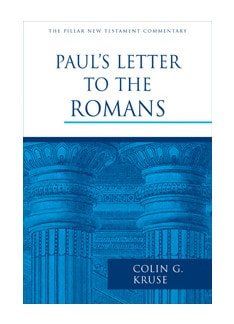Paul’s letter to the Romans
Colin G. Kruse
IVP Apollos, 656 pages, £34.99
ISBN: 978-1-84474-582-1
Star Rating : 3
In the Pillar New Testament Commentaries, this volume replaces the previous commentary on Romans by Leon Morris. Those who love the apostle Paul’s letter to the Romans will be happy to have both Morris and Kruse. In some areas Morris is superior.
Considerable value has been added to this volume by including 49 essays woven into the book on matters that arise in the text.
These cover such subjects as: ‘The identity of the “I” in 7:7-25’; ‘The nature of homosexual practice condemned by Paul’; ‘All Israel will be saved’; ‘Baptism in the Pauline corpus’; ‘The righteousness of God’; ‘Hospitality’; ‘The wrath of God and Israel’s jealousy’; ‘The influence of the New Perspective (Sanders and Dunn)’, and ‘The work of the Trinity in Romans’.
The bibliography of modern authors runs to six pages. Hodge and Haldane are omitted. The modern commentators and scholars most interacted with and most cited are C. K. Barratt, B. Byrne, C. E. B. Cranfield, J. D. G. Dunn, J. A. Fitzmyer, Robert Jewett, E. Kasemann, D. Moo, T. R. Schreiner and N. T. Wright.
In stating the purpose of Romans, Kruse places first Paul’s intention to present a clear statement of what the gospel is, and second his desire for unity among Jewish and Gentile believers in Rome.
On Romans 1:16-17, Kruse cites Cranfield as interpreting the righteousness of God in 1:17 as the status of righteousness that God bestows on those who believe. Instead of pressing home that meaning, Kruse goes on to discuss an abstruse alternative view.
This early approach — of concern with different ways that the text can be interpreted — is the style followed through much of this commentary. It reaches absurdity in Romans 7, when Kruse outlines no less than ten ways in which Romans 7:7-25 can be interpreted!
The eclectic approach is used again by Kruse in explaining Romans 11. There he describes six different interpretations. In his introduction, under the heading ‘Israel in the purposes of God’ (p.29), he takes the view that Paul is declaring that Israel’s acceptance of the gospel will be as ‘life from the dead’ for the Gentiles.
Later, in outlining the six different ways of taking Romans 11, Kruse changes his position and embraces the idea that ‘all Israel’ is the accumulation of believing Jews over a long period of time. Jews converted here and there is one thing, but Jews believing as a ‘fullness’ is another.
The eclectic style of exploring all the possibilities has some advantages, but the power of truth is often lost in too many irrelevant details. I came to the doctrines of grace through reading Robert Haldane on Romans 1-3. I ignored those parts where Haldane refutes the liberals of his time, because my concern was to digest the plain meaning of the Romans text. To be fair to Kruse, he is concerned for that, but concedes too much.
Kruse is rock solid on Romans 1 and the doctrine of sin. He exposes the fallacies of the New Perspective. He has unearthed some priceless quotes. There is one from Jacob Neusner, a prolific Jewish author, who says that, ‘in regard to Rabbinic Judaism, Sander’s book is so profoundly flawed as to be hopeless’. A useful and scholarly book.
Erroll Hulse
Leeds





